- Stay Connected
 Abraham Lincoln
If given the truth, the people can be depended upon to meet any national crisis...
Abraham Lincoln
If given the truth, the people can be depended upon to meet any national crisis...
 Guildford news...
for Guildford people, brought to you by Guildford reporters - Guildford's own news service
Guildford news...
for Guildford people, brought to you by Guildford reporters - Guildford's own news service
From Woodbridge Park To Western Australia
Published on: 28 Feb, 2012
Updated on: 1 Dec, 2019
by David Rose
Building work is nearing completion on the new store for trade and DIY retailer Wickes at Woodbridge Road in Guildford. It is on the site of a house with connections to the man who was the founding governor of Western Australia, Admiral Sir James Stirling.
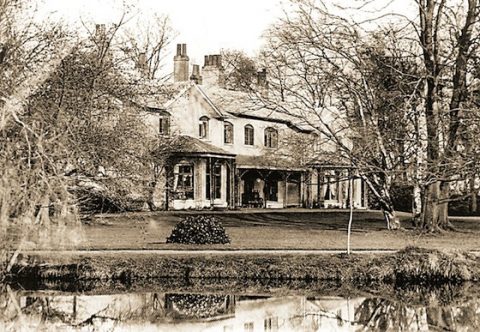
- The house beside the River Wey at Woodbridge in Guildford in about the 1870s. It was known as Woodbridge Park and Woodbridge House at different times, and was once the home of James Mangles MP.
When the foundations for the new Wickes store were being dug a few months ago some traces of what was Woodbridge Park / House surfaced. These included a number of bricks among other building rubble, that I imagine were from the original house.

- Site where the old house once stood being redeveloped once again, this time for a Wickes building trade and DIY retail store.
In the book Stoke Next Guildford (Phillimore 1999), the author Lyn Clark notes that many years ago there were two houses near the River Wey at Woodbridge. She wrote: “Nearest the river with lawns running down to the water stood a house which on the Tithe Award Map is called Woodbridge House. East of this property, to the west of Woodbridge Road, stood another house labelled ‘Mansion Garden Lawn’. On the 1912 6in OS map what had been Woodbridge House in 1841 is Woodbridge Park, while the ‘mansion’ of 1841 is called Woodbridge House. Both of them have long disappeared so perhaps it does not matter that different houses were known by the same name at different times.”
It is the house nearest to the river that we are concerned about here.
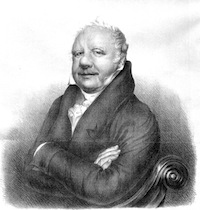
- James Mangles – ‘Old Potato Face’. These images are from the book James Stirling by Pamela Stratham Drew.
James Mangles (1761-1838) was the son of a ship chandler from Wapping in London. With his brother John, James built up a successful shipping company that traded with Australia and the East Indies.
James came to live at the house in Woodbridge near the river after he married Mary Hughes (1776-1852) at Worplesdon, in 1791.
He and his brother were rather enterprising and founded the Mangles Bank in Guildford. James became High Sheriff for Surrey in 1807, and was Guildford’s MP from 1832-37, representing the Liberal Party. His nickname was ‘Old Potato Face’, due to his bulbous nose. He had a loud voice and didn’t do things by halves.
It’s said he once owned a yellow coach with his crest and coat of arms painted on each side. The coat of arms featured two black crosses separated by a diagonal blue and white band, with two leopards and three fleurs-de-lis. The coachman and footman were suitable attired in matching uniform of yellow and buff.
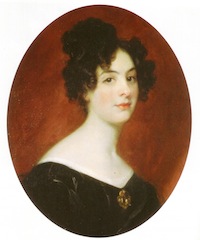
- Ellen Stirling (nee Mangles).
James and Mary had 12 children. Their daughter Ellen married the dashing James Stirling (1791-1865) on her 16th birthday in 1823. For a time they lived at the Mangles home in Woodbridge.
James Stirling was born near Glasgow into a well-to-do family. Educated at Westminster School in London, he joined the Royal Navy at the age of 12 and rose rapidly through the ranks.
His family leased Henley Park mansion near Normandy, Guildford, and when on shore leave he would regularly visit them.
The Stirlings and the Mangles acquainted themselves with each other – most likely through James Mangles’ shipping interests and the Stirling’s connections with the Royal Navy. James met Ellen when on a visit to Woodbridge, while he was between naval commissions and on half pay.
In 1826, he was given command of a new ship, the Success, and set sail to form a settlement in Raffles Bay, Torres Strait, due to French activity in the Pacific.

- Admiral Sir James Stirling, the first governor of Western Australia.
However, it was the monsoon season when he got there, and rather than being holed up in Botany Bay, it was decided to send Stirling to have a look at the coast of western Australia instead, to see if the Dutch or French were up to anything there.
When he found land, Stirling sailed up the Swan River and soon realised it was the perfect place to form a British settlement.
In fact, what he discovered led him to take the initiative single-handedly to found the new state of Western Australia in 1829. He did this with little capital and a lack of support from the British government.
Place names of the new colony reflected those from back home. For example there is a town of Guildford, a Mangles Bay and a Woodbridge Creek.
But this was not all, his other great achievements were commanding various warships and being a major player in Britain’s foreign policy in the Mediterranean, controlling pirates and Chinese rebel attacks on Shanghai, and negotiating Britain’s first treaty with Japan.
Not long after James and Ellen returned to Woodbridge, Guildford, he died here on April 22, 1865. Ellen died in 1874 and they are buried at the church where they were married – St John’s in Stoke Road.
In 1981 their grave cover stone was reassembled then relocated to between church and adjacent Stirling Centre, which is of course, named after him. Following a 2015 analysis and mapping of burial record notations, an exploratory dig in May 2017 located their grave on the western churchyard boundary.
The house remained long after the Mangles’ association with it. Luckily there are photos of it, plus the watercolour painting, seen here.
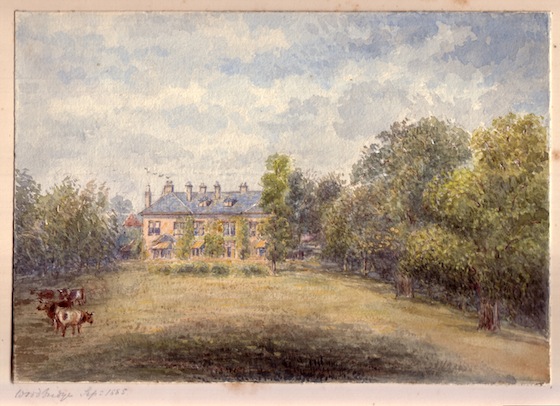
- A watercolour painting of Woodbridge Park by an unknown artist but dated 1885. Chris Quinn collection.
At the time of writing, I can’t say exactly when it was demolished. From my run of town directories, it seems to have been converted into flats by at least the 1930s.

- I think this is the same view today as seen in the watercolour above, although I stood on the opposite bank of the river to take this photo.
This was the case as found in the 1965/66 edition of the Kelly’s Directory of Guildford & Godalming. However, there is no listing at all by the time of the 1967 edition.
Perhaps by then the house had been vacated and was awaiting demolition. By the early 1970s an industrial park had been built across the site and I recall that the firm Readymix Concrete had premises and a yard on or about the site of the old house.
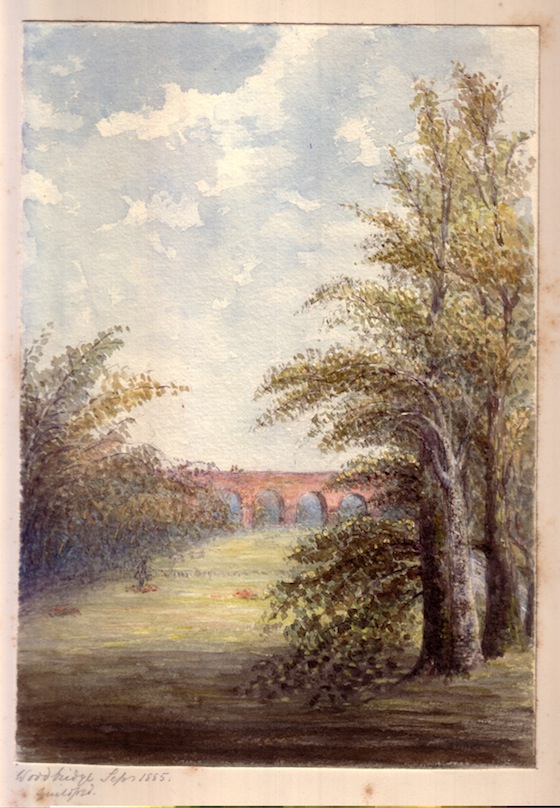
- Another watercolour by the unknown artist. The view is from the bottom of the garden at Woodbridge Park looking upstream towards Guildford town with the ‘seven arches’ railway bridge in view. The artist has just included the river on the far right-hand side of the painting. The railway bridge, taking the ‘New Line’ to London Waterloo via Cobham, would have been a new addition to the landscape at the time the painting was done. Chris Quinn collection.
Later still a further building was put up and was used by Biddles as a print works. That was until about 2004 when the firm left Guildford concentrating its business at its works in King’s Lynn in Norfolk.
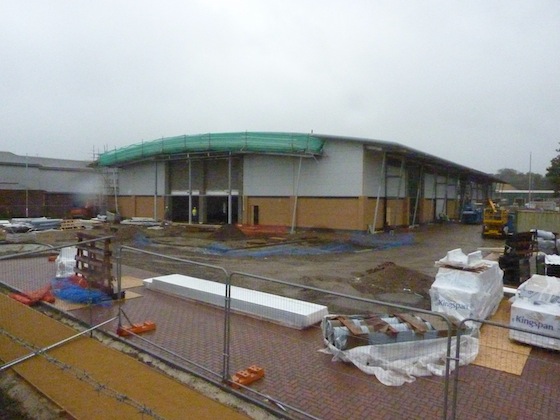
- The new Wickes store pictured a couple of weeks ago (2012).

















Recent Comments